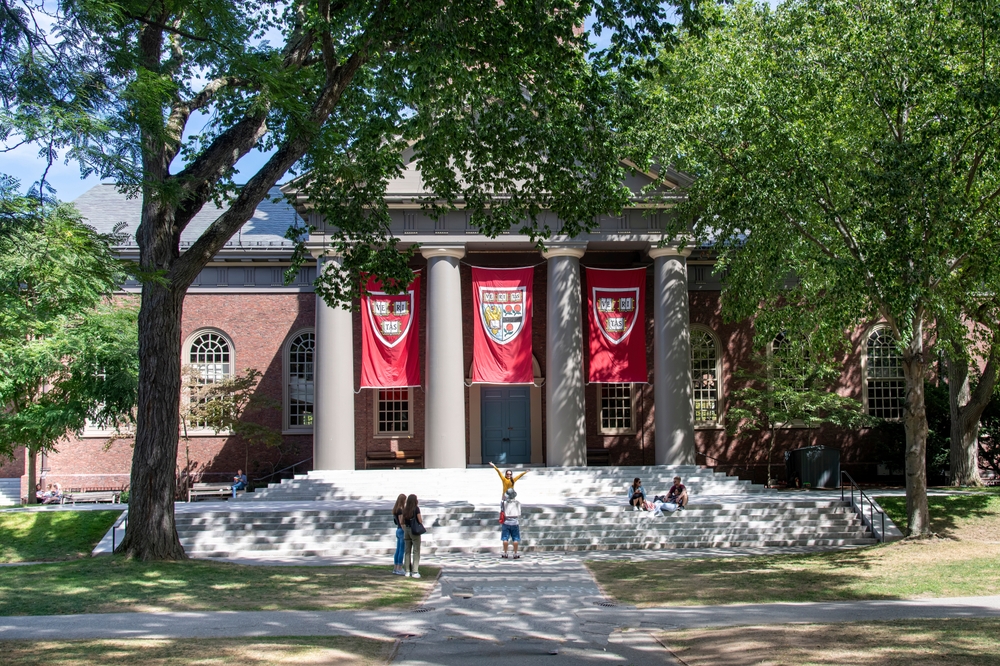The U.S. Supreme Court’s June 2023 ruling in Students for Fair Admissions, Inc. v. President and Fellows of Harvard College (SFFA), which invalidated the use of race as a criterion for college admissions, dominated several summer news cycles and prompted no shortage of opinion pieces and responses. Little of this commentary focused, however, on the long and complicated history that the university at the center of the case has with issues of diversity and representation. That history provides important context for understanding the recent ruling, but also insight into how a place like Harvard—an institution that once explicitly (and now merely implicitly) considered itself an arbiter of which people and ideas belonged at the top of America’s intellectual and social hierarchy—viewed and treated the individuals and groups that sought access to the school.
Thankfully, a book published shortly before the court’s decision—Zev Eleff’s Dyed in Crimson: Football, Faith, and Remaking Harvard’s America—recounts past events that give readers an idea of the ways in which Harvard (and, by logical extension, other powerful institutions) has handled (and mishandled) the issue of inclusion throughout its history. Perhaps more importantly, it shows how individuals from disfavored groups have in the past been able to excel without the help of, and in fact despite, racial quotas.
Eleff’s book focuses on the period 1913–’30, when Harvard’s diversity struggles involved the admission of anyone who was not a white Protestant male of high social class. Recent immigrants and their children, working-class males (females would not be admitted to the college until the 1940s), Jews, and Catholics were the groups whose suitability for admission was being debated by the school’s administrators and alumni. The book thus focuses on two figures from these “outside” groups who brought with them to Harvard particular gifts and nontraditional identities, first as students and later as employees. Both excelled in athletics in a way that not only redounded to the school’s great benefit but also proved the real value offered by the genuine diversity that only meritocracy, and not quotas, can produce.
The first of the book’s protagonists is Bill Bingham, a suitably Protestant but unfashionably ethnic and working-class son of immigrants from Northern Ireland who had settled in the Massachusetts industrial town of Lawrence. By age 14, Bingham was working in a mill “earning $4.95 for fifty-eight hours of weekly labor.” It was a schedule so typical for Lawrence residents of his age that the local public school accommodated them by holding classes at night for working teens. But Bill was much more than a working teen, and in his adolescence had already become a star in regional running circuits. Trained at the YMCA and imbued with an explicit sense of Christian rectitude, Bingham became a local sports hero.
Supported by his community’s fundraising ($30) and his own savings ($30), he set off for the elite Phillips Exeter school with enough funds for “a couple of months” of attendance. The community support came with an implicit mission, Eleff conveys, as “his friends and family dispatched Bill from Lawrence to spread [the] gospel of merit and accountability to the parts of the United States that tended to privilege family connections and class rather than these blue-collar ideas.” Bill took this mission seriously, earning a scholarship that permitted him to stay at the school after his own $60 had been spent. His running exploits launched him into prominence both at Phillips Exeter and in national athletic circles. This success would continue through a distinguished career at Harvard, where he enrolled in 1913.
Arnold Horween’s upbringing shared many characteristics with Bill Bingham’s. The Jewish son of Ukrainian immigrants in Chicago, Horween distinguished himself on the football field, leading his school’s team to great success. He would go on to gain admission to Harvard (enrolling in 1916) and subsequently star in the university’s already-storied gridiron program. Eleff points out that Horween, raised in a city where three quarters of the population were immigrants or the children of immigrants, was, much like Bingham, reared and influenced by “women and men [who] ‘saw themselves as good Americans,’ part of a ‘patriotic pluralism.’ … Their trust in America was taught through faith and family.” As the author makes clear, Horween’s blue-collar background and youth in a recent-immigrant milieu meant he was “raised to pay attention to merit rather than race or creed.”
Eleff recounts both men’s collegiate sporting exploits in detail, including Bingham’s battle for NCAA supremacy against the Olympic gold medalist and University of Pennsylvania student Ted Meredith and Horween’s leadership of the Crimson to the pinnacle of American football (complete with the school’s only Rose Bowl appearance in its history). Detailed as they are, these stories of sporting excellence mostly serve to set the stage for a segment of both men’s lives that Eleff emphasizes even more: their return to the university to assume athletic leadership positions. Bingham initially came back to campus as the track and field coach but was later (in 1926) selected as the school’s first athletic director. He would shortly thereafter hire a kindred spirit to lead the school’s football program. That hire, Arnold Horween, would, somewhat controversially, be the first Jewish head football coach in Harvard history.
In the author’s telling, this was no minor development. Given the country’s history to that point, the elevation of a Jewish person to a high position in a prominent and influential American institution would indeed have been controversial under any circumstances. But it just so happened that Bingham was making his hire during a leadership tenure at Harvard that was particularly marked by active anti-Semitism. Eleff outlines the manner in which long-time Harvard president Abbott Lawrence Lowell had sought to limit Jewish attendance at the university, feeling that “where Jews become numerous they drive off other people and then leave themselves” and instituting a quota for Jewish attendance as part of what he called a “race distribution” scheme.
Lowell’s proposed plan, which would have required applicants to list various personal details so they could be categorized on a scale from J1 (“conclusively Jewish”) to J3 (“might be Jewish”), was rejected in 1923. Nonetheless, quotas were effectively used, and a very real anti-Semitism pervaded the Harvard community by the time Arnold Horween took the helm of the school’s football program in 1926. Writing about the pending hire, Harvard’s head of admissions and chair of the athletic committee, Henry Pennypacker, noted that “I am really doubtful if we could expediently invite any member of the Hebrew race to become Head Coach no matter how skillful he might be. There is a settled feeling, apparently very widespread, that we must do something at once to check certain influences.”
But hired Horween was. Now installed in the most influential athletic positions at the country’s most elite academic institution, he and Bingham set about instilling their values in Harvard sports. Eleff covers this material in depth, outlining the pair’s accomplishments and Horween’s embrace of then-controversial procedures like huddles and forward passes. More than anything, though, he meditates on how the men’s outsider status allowed them to pursue a renewed athletic culture that rightly aligned winning, sportsmanship, fun, and hard work.
All this is fine material and worth reading, but considering the book in the context of 2023’s legal news is even more valuable. Reading of Lowell’s anti-Jewish machinations, and Horween’s relative success as both player and coach despite them, should resonate with today’s observers, not least of all because Lowell’s Jewish admissions quota was extensively discussed in the oral arguments and written decision of the 2023 SFFA case. Justices Neil Gorsuch and Samuel Alito, along with the petitioners’ attorney, repeatedly brought up the comparison between Harvard’s treatment of Jews in the 1920s and that of Asians today.
In response to the comparison, some observers have insisted that recent “holistic” admissions efforts, because they were designed to enhance the presence of underrepresented groups, were actually wholly different in character to Lowell’s machinations, which were intended to curb such presence. That’s a fine argument about intent, but it conveniently ignores the fact that contemporary race-conscious admissions policies did inarguably have the effect of reducing representation of certain minority groups (just as Lowell’s efforts did), thus evidencing the dangers of even well-intended racial scoring.
This is perhaps one reason that race-conscious college admissions continually polls poorly among Americans. For its part, the Harvard community—despite the court’s recent ruling and the school’s own embarrassing history with exclusionary quotas—remains steadfastly committed to the idea that the consideration of race is entirely appropriate in deciding who might attend their prestigious university. That’s unfortunate, especially given the lessons taught by Bill Bingham and Arnold Horween, who brought diversity of identity and viewpoint to Harvard through the force of their own old-fashioned, son-of-immigrant beliefs and work ethic: that commitment, strong moral values, and merit can advance individuals and institutions in a way no other characteristics can.

